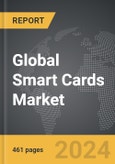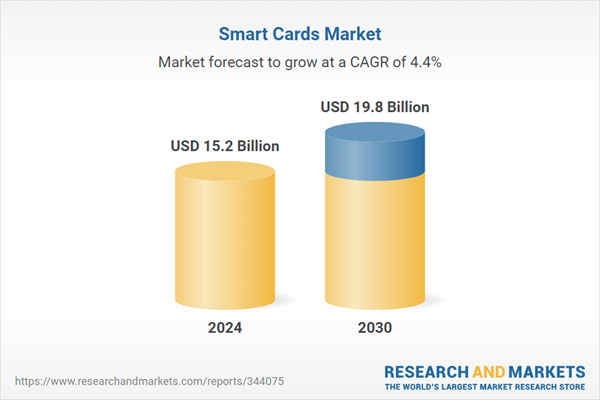Global Smart Cards Market - Key Trends & Drivers Summarized
What Are Smart Cards, and How Are They Integral to Modern Transactions?
Smart cards are pocket-sized cards embedded with integrated circuits that are capable of data storage, transaction processing, and authentication. They come in two primary forms: contact and contactless. Contact smart cards require direct contact with a reader, while contactless cards utilize Radio Frequency Identification (RFID) technology or Near-Field Communication (NFC) to make secure transactions possible without physical contact. These cards are increasingly used for a variety of purposes including financial transactions, personal identification, access control, and secure mobile communications. The data storage capability allows for the storage of an individual's personal data, while the processing power can manage encryption and mutual authentication processes, making smart cards a robust tool for secure and private data exchange in our digital age.How Do Smart Cards Enhance Security and Usability?
Smart cards provide a higher level of security compared to magnetic stripe cards due to their encrypted microprocessor chips, which are extremely difficult to replicate. This encryption capability makes smart cards an excellent choice for handling sensitive information such as identity credentials, banking information, and personal health records. Additionally, the versatility of smart cards is evident in their wide range of applications, from EMV chip cards used in banking to identification cards used in government security systems. They are also essential in the deployment of digital wallets and mobile payment systems, which rely on secure elements within smartphones that function similarly to smart cards. The ability to integrate multiple applications on a single card enhances usability and convenience for users, promoting a seamless integration of various services and functionalities.What Trends Are Shaping the Future of Smart Cards?
The smart card industry is rapidly evolving, influenced by technological advancements and the increasing demand for high-security portable tokens. One significant trend is the shift towards dual-interface cards, which combine the contact and contactless technologies in a single card. This integration offers greater flexibility and convenience for users and is particularly beneficial in environments that require a fast processing time without sacrificing security, such as transit systems or access control systems. Another growing trend is the use of biometric smart cards, which incorporate features such as fingerprint sensors for enhanced security verification. These innovations are part of a broader movement towards more personalized and secure methods of verifying user identity, reflecting a market that values both security and efficiency.What Drives the Growth in the Smart Cards Market?
The growth in the smart cards market is driven by several factors, including the widespread adoption of EMV technology in financial transactions, governmental regulations mandating enhanced security measures for identification documents, and the global push towards digitalization of payment systems. The increasing concern over data breaches and identity theft has also prompted industries to adopt more secure transaction technologies, with smart cards positioned as a premier choice. Furthermore, the expansion of telecommunications infrastructure globally has led to a higher demand for SIM cards, which are a type of smart card. Consumer behavior that leans towards convenient, quick, and secure transaction methods, such as contactless payments, drives the demand for advanced smart cards. Additionally, the rise in smart city initiatives promoting smart transportation systems and secured access to government services further propels the adoption of smart card technology, demonstrating its growing indispensability in a connected, digital world.Report Scope
The report analyzes the Smart Cards market, presented in terms of market value (USD). The analysis covers the key segments and geographic regions outlined below.- Segments: Application (Telecommunication, BFSI, Government & Healthcare, and Other Verticals).
- Geographic Regions/Countries: World; USA; Canada; Japan; China; Europe; France; Germany; Italy; UK; Spain; Russia; Rest of Europe; Asia-Pacific; Australia; India; South Korea; Rest of Asia-Pacific; Latin America; Argentina; Brazil; Mexico; Rest of Latin America; Middle East; Iran; Israel; Saudi Arabia; UAE; Rest of Middle East; Africa.
Key Insights:
- Market Growth: Understand the significant growth trajectory of the Telecommunication Application segment, which is expected to reach US$9.7 Billion by 2030 with a CAGR of 4.7%. The BFSI Application segment is also set to grow at 4% CAGR over the analysis period.
- Regional Analysis: Gain insights into the U.S. market, valued at $2.1 Billion in 2024, and China, forecasted to grow at an impressive 5.5% CAGR to reach $5.4 Billion by 2030. Discover growth trends in other key regions, including Japan, Canada, Germany, and the Asia-Pacific.
Why You Should Buy This Report:
- Detailed Market Analysis: Access a thorough analysis of the Global Smart Cards Market, covering all major geographic regions and market segments.
- Competitive Insights: Get an overview of the competitive landscape, including the market presence of major players across different geographies.
- Future Trends and Drivers: Understand the key trends and drivers shaping the future of the Global Smart Cards Market.
- Actionable Insights: Benefit from actionable insights that can help you identify new revenue opportunities and make strategic business decisions.
Key Questions Answered:
- How is the Global Smart Cards Market expected to evolve by 2030?
- What are the main drivers and restraints affecting the market?
- Which market segments will grow the most over the forecast period?
- How will market shares for different regions and segments change by 2030?
- Who are the leading players in the market, and what are their prospects?
Report Features:
- Comprehensive Market Data: Independent analysis of annual sales and market forecasts in US$ Million from 2024 to 2030.
- In-Depth Regional Analysis: Detailed insights into key markets, including the U.S., China, Japan, Canada, Europe, Asia-Pacific, Latin America, Middle East, and Africa.
- Company Profiles: Coverage of players such as Bartronics India Ltd., ASSA ABLOY AB, CPI Card Group, Inc., American Express Company, CardLogix Corporation and more.
- Complimentary Updates: Receive free report updates for one year to keep you informed of the latest market developments.
Some of the 121 companies featured in this Smart Cards market report include:
- Bartronics India Ltd.
- ASSA ABLOY AB
- CPI Card Group, Inc.
- American Express Company
- CardLogix Corporation
- AVI Infosys LLC
- Activation Power System
- Blue
- Card Cube Group
- Camgian Microsystems
- ABCorp
- Cardmatix
- AdvanIDe
- Austriacard Holdings AG
- BrilliantTS
This edition integrates the latest global trade and economic shifts into comprehensive market analysis. Key updates include:
- Tariff and Trade Impact: Insights into global tariff negotiations across 180+ countries, with analysis of supply chain turbulence, sourcing disruptions, and geographic realignment. Special focus on 2025 as a pivotal year for trade tensions, including updated perspectives on the Trump-era tariffs.
- Adjusted Forecasts and Analytics: Revised global and regional market forecasts through 2030, incorporating tariff effects, economic uncertainty, and structural changes in globalization. Includes historical analysis from 2015 to 2023.
- Strategic Market Dynamics: Evaluation of revised market prospects, regional outlooks, and key economic indicators such as population and urbanization trends.
- Innovation & Technology Trends: Latest developments in product and process innovation, emerging technologies, and key industry drivers shaping the competitive landscape.
- Competitive Intelligence: Updated global market share estimates for 2025, competitive positioning of major players (Strong/Active/Niche/Trivial), and refined focus on leading global brands and core players.
- Expert Insight & Commentary: Strategic analysis from economists, trade experts, and domain specialists to contextualize market shifts and identify emerging opportunities.
Table of Contents
Companies Mentioned (Partial List)
A selection of companies mentioned in this report includes, but is not limited to:
- Bartronics India Ltd.
- ASSA ABLOY AB
- CPI Card Group, Inc.
- American Express Company
- CardLogix Corporation
- AVI Infosys LLC
- Activation Power System
- Blue
- Card Cube Group
- Camgian Microsystems
- ABCorp
- Cardmatix
- AdvanIDe
- Austriacard Holdings AG
- BrilliantTS
Table Information
| Report Attribute | Details |
|---|---|
| No. of Pages | 461 |
| Published | December 2025 |
| Forecast Period | 2024 - 2030 |
| Estimated Market Value ( USD | $ 15.2 Billion |
| Forecasted Market Value ( USD | $ 19.8 Billion |
| Compound Annual Growth Rate | 4.4% |
| Regions Covered | Global |









